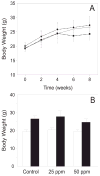Examination of the effects of arsenic on glucose homeostasis in cell culture and animal studies: development of a mouse model for arsenic-induced diabetes
- PMID: 17336358
- PMCID: PMC2680915
- DOI: 10.1016/j.taap.2007.01.010
Examination of the effects of arsenic on glucose homeostasis in cell culture and animal studies: development of a mouse model for arsenic-induced diabetes
Abstract
Previous epidemiologic studies found increased prevalences of type 2 diabetes mellitus in populations exposed to high levels of inorganic arsenic (iAs) in drinking water. Although results of epidemiologic studies in low-exposure areas or occupational settings have been inconclusive, laboratory research has shown that exposures to iAs can produce effects that are consistent with type 2 diabetes. The current paper reviews the results of laboratory studies that examined the effects of iAs on glucose metabolism and describes new experiments in which the diabetogenic effects of iAs exposure were reproduced in a mouse model. Here, weanling male C57BL/6 mice drank deionized water with or without the addition of arsenite (25 or 50 ppm As) for 8 weeks. Intraperitoneal glucose tolerance tests revealed impaired glucose tolerance in mice exposed to 50 ppm As, but not to 25 ppm As. Exposure to 25 and 50 ppm As in drinking-water resulted in proportional increases in the concentration of iAs and its metabolites in the liver and in organs targeted by type 2 diabetes, including pancreas, skeletal muscle and adipose tissue. Dimethylarsenic was the predominant form of As in the tissues of mice in both 25 and 50 ppm groups. Notably, the average concentration of total speciated arsenic in livers from mice in the 50 ppm group was comparable to the highest concentration of total arsenic reported in the livers of Bangladeshi residents who had consumed water with an order of magnitude lower level of iAs. These data suggest that mice are less susceptible than humans to the diabetogenic effects of chronic exposure to iAs due to a more efficient clearance of iAs or its metabolites from target tissues.
Figures





References
-
- Alam MG, Allinson G, Stagnitti F, Tanaka A, Westbrooke M. Arsenic contamination in Bangladesh groundwater: a major environmental and social disaster. Int J Environ Health Res. 2002;12:235–253. - PubMed
-
- Bates MN, Smith AH, Cantor KP. Case-control study of bladder cancer and arsenic in drinking water. Am J Epidemiol. 1995;141:523–530. - PubMed
-
- Bates MN, Smith AH, Hopenhayn-Rich C. Arsenic ingestion and internal cancers: a review. Am J Epidemiol. 1992;135:462–476. - PubMed
-
- Bazuine M, Carlotti F, Tafrechi RS, Hoeben RC, Maassen JA. Mitogen-activated protein kinase (MAPK) phosphatase-1 and -4 attenuate p38 MAPK during dexamethasone-induced insulin resistance in 3T3-L1 adipocytes. Mol Endocrinol. 2004;18:1697–1707. - PubMed
-
- Bazuine M, Ouwens DM, Gomes de Mesquita DS, Maassen JA. Arsenite stimulated glucose transport in 3T3-L1 adipocytes involves both Glut4 translocation and p38 MAPK activity. Eur J Biochem. 2003;270:3891–3903. - PubMed
Publication types
MeSH terms
Substances
Grants and funding
LinkOut - more resources
Full Text Sources
Medical
Research Materials

